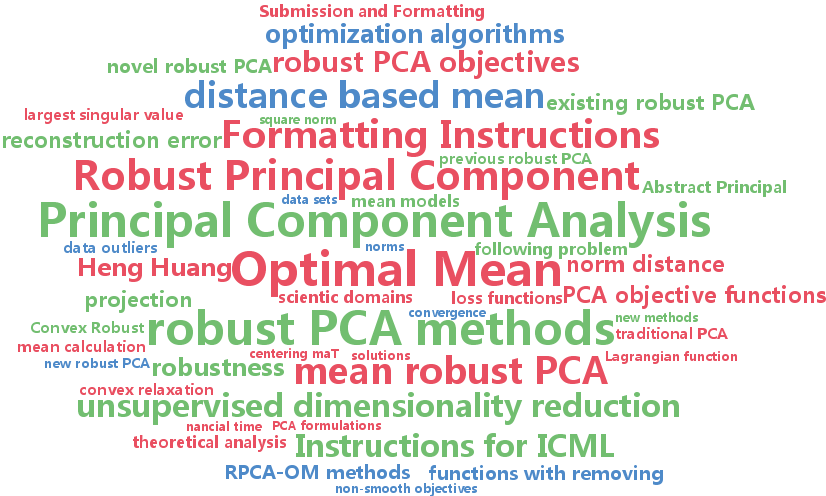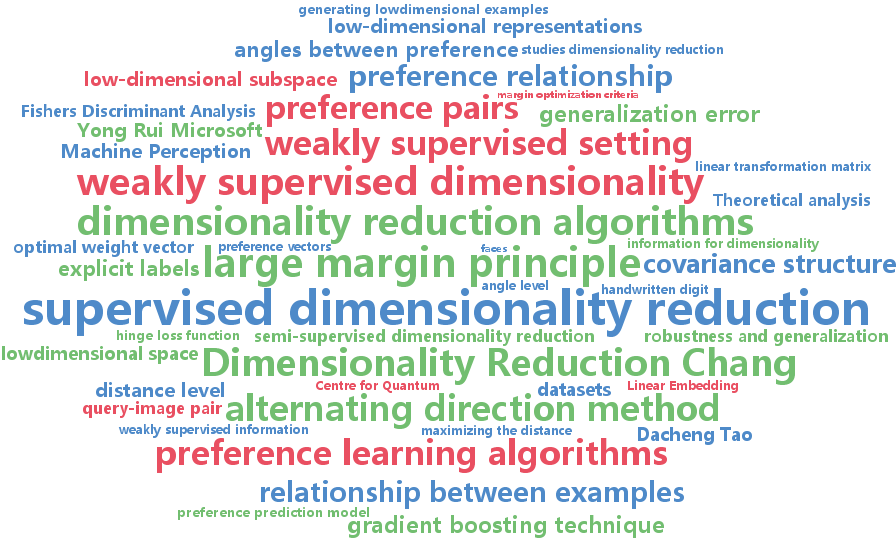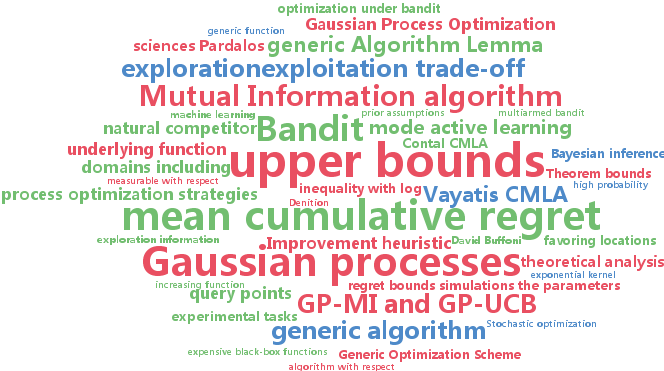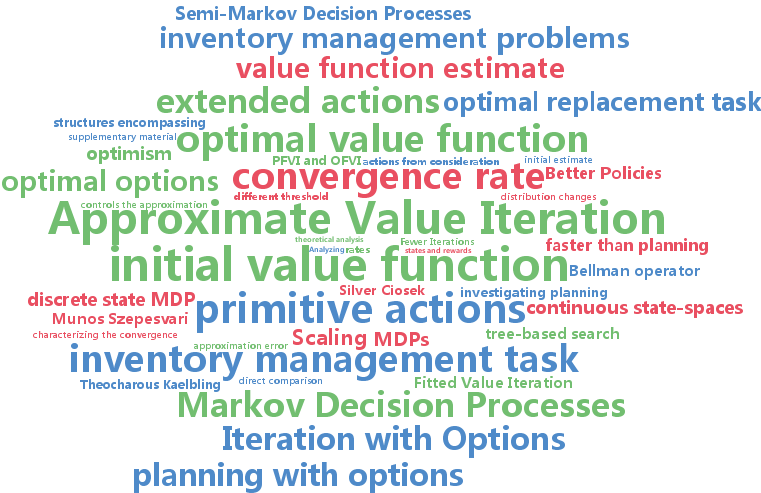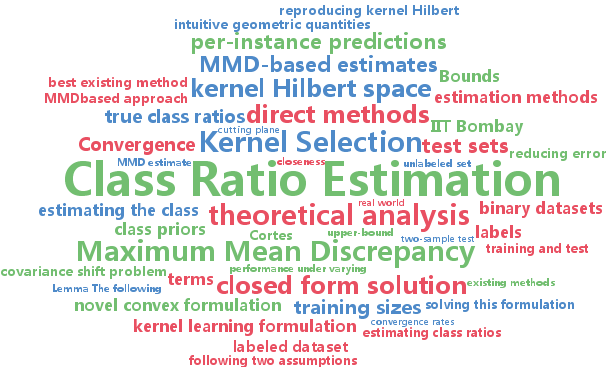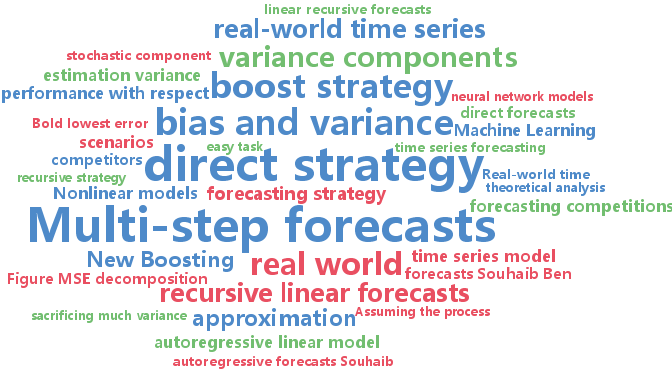theoretical analysis
-
Feiping Nie and Jianjun Yuan and Heng Huang
Optimal Mean Robust Principal Component Analysis (pdf)
Dimensionality reduction techniques extract low-dimensional structure from high-dimensional data and are widespread in machine learning research. In practice, due to lacking labeled data, the unsupervised dimensionality reduction algorithms are more desired. Among them, Principal Component Analysis (PCA) is the most widely used approach. In recent research, several robust PCA algorithms were presented to enhance the robustness of PCA model. However, all existing robust PCA methods incorrectly center the data using the L2-norm distance to calculate the mean, which actually is not the optimal mean due to the L1-norm used in the objective functions. It is non-trivial to remove the optimal mean in the robust PCA, because of the sparsity-inducing norms used in the robust formulations. In this paper, we propose novel robust PCA objective functions with removing optimal mean automatically. We naturally integrate the mean calculation into the dimensionality reduction optimization, such that the optimal mean can be obtained to enhance the dimensionality reduction. Both theoretical analysis and empirical studies demonstrate our new methods can more effectively reduce data dimensionality than previous robust PCA methods.
-
Chang Xu and Dacheng Tao and Chao Xu and Yong Rui
Large-margin Weakly Supervised Dimensionality Reduction (pdf)
This paper studies dimensionality reduction in a weakly supervised setting, in which the preference relationship between examples is indicated by weak cues. A novel framework is proposed that integrates two aspects of the large margin principle (angle and distance), which simultaneously encourage angle consistency between preference pairs and maximize the distance between examples in preference pairs. Two specific algorithms are developed: an alternating direction method to learn a linear transformation matrix and a gradient boosting technique to optimize a non-linear transformation directly in the function space. Theoretical analysis demonstrates that the proposed large margin optimization criteria can strengthen and improve the robustness and generalization performance of preference learning algorithms on the obtained low-dimensional subspace. Experimental results on real-world datasets demonstrate the significance of studying dimensionality reduction in the weakly supervised setting and the effectiveness of the proposed framework.
-
Bojun Tu and Zhihua Zhang and Shusen Wang and Hui Qian
Making Fisher Discriminant Analysis Scalable (pdf)
The Fisher linear discriminant analysis (LDA) is a classical method for classification and dimension reduction jointly. A major limitation of the conventional LDA is a so-called singularity issue. Many LDA variants, especially two-stage methods such as PCA+LDA and LDA/QR, were proposed to solve this issue. In the two-stage methods, an intermediate stage for dimension reduction is developed before the actual LDA method works. These two-stage methods are scalable because they are an approximate alternative of the LDA method. However, there is no theoretical analysis on how well they approximate the conventional LDA problem. In this paper we present theoretical analysis on the approximation error of a two-stage algorithm. Accordingly, we develop a new two-stage algorithm. Furthermore, we resort to a random projection approach, making our algorithm scalable. We also provide an implemention on distributed system to handle large scale problems. Our algorithm takes LDA/QR as its special case, and outperforms PCA+LDA while having a similar scalability. We also generalize our algorithm to kernel discriminant analysis, a nonlinear version of the classical LDA. Extensive experiments show that our algorithms outperform PCA+LDA and have a similar scalability with it.
-
Emile Contal and Vianney Perchet and Nicolas Vayatis
Gaussian Process Optimization with Mutual Information (pdf)
In this paper, we analyze a generic algorithm scheme for sequential global optimization using Gaussian processes. The upper bounds we derive on the cumulative regret for this generic algorithm improve by an exponential factor the previously known bounds for algorithms like GP-UCB. We also introduce the novel Gaussian Process Mutual Information algorithm (GP-MI), which significantly improves further these upper bounds for the cumulative regret. We confirm the efficiency of this algorithm on synthetic and real tasks against the natural competitor, GP-UCB, and also the Expected Improvement heuristic.
-
Timothy Mann and Shie Mannor
Scaling Up Approximate Value Iteration with Options: Better Policies with Fewer Iterations (pdf)
We show how options, a class of control structures encompassing primitive and temporally extended actions, can play a valuable role in planning in MDPs with continuous state-spaces. Analyzing the convergence rate of Approximate Value Iteration with options reveals that for pessimistic initial value function estimates, options can speed up convergence compared to planning with only primitive actions even when the temporally extended actions are suboptimal and sparsely scattered throughout the state-space. Our experimental results in an optimal replacement task and a complex inventory management task demonstrate the potential for options to speed up convergence in practice. We show that options induce faster convergence to the optimal value function, which implies deriving better policies with fewer iterations.
-
Arun Iyer and Saketha Nath and Sunita Sarawagi
Maximum Mean Discrepancy for Class Ratio Estimation: Convergence Bounds and Kernel Selection (pdf)
In recent times, many real world applications have emerged that require estimates of class ratios in an unlabeled instance collection as opposed to labels of individual instances in the collection. In this paper we investigate the use of maximum mean discrepancy (MMD) in a reproducing kernel Hilbert space (RKHS) for estimating such ratios. First, we theoretically analyze the MMD-based estimates. Our analysis establishes that, under some mild conditions, the estimate is statistically consistent. More importantly, it provides an upper bound on the error in the estimate in terms of intuitive geometric quantities like class separation and data spread. Next, we use the insights obtained from the theoretical analysis, to propose a novel convex formulation that automatically learns the kernel to be employed in the MMD-based estimation. We design an efficient cutting plane algorithm for solving this formulation. Finally, we empirically compare our estimator with several existing methods, and show significantly improved performance under varying datasets, class ratios, and training sizes.
-
Souhaib Ben Taieb and Rob Hyndman
Boosting multi-step autoregressive forecasts (pdf)
Multi-step forecasts can be produced recursively by iterating a one-step model, or directly using a specific model for each horizon. Choosing between these two strategies is not an easy task since it involves a trade-off between bias and estimation variance over the forecast horizon. Using a nonlinear machine learning model makes the tradeoff even more difficult. To address this issue, we propose a new forecasting strategy which boosts traditional recursive linear forecasts with a direct strategy using a boosting autoregression procedure at each horizon. First, we investigate the performance of the proposed strategy in terms of bias and variance decomposition of the error using simulated time series. Then, we evaluate the proposed strategy on real-world time series from two forecasting competitions. Overall, we obtain excellent performance with respect to the standard forecasting strategies.
